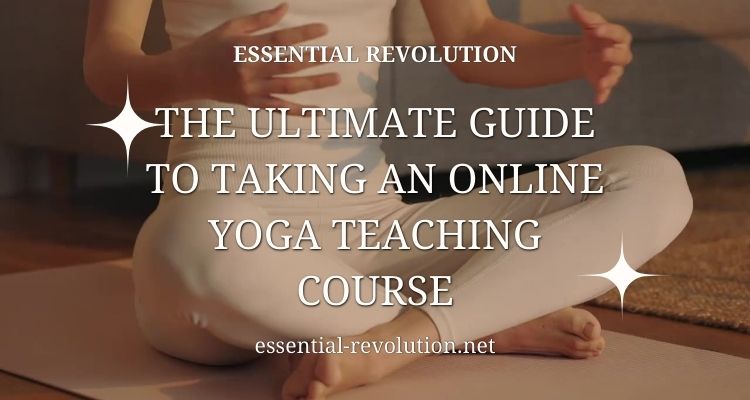Embarking on an online yoga teaching course can be a transformative experience, providing flexibility knowledge from the comfort of your home.
Embarking on an online yoga teaching course can be a transformative experience, providing flexibility as well as comprehensive knowledge from the comfort of your home.
Why Choose an Online Yoga Teaching Course?
In today’s fast-paced world, finding time to attend in-person classes can be challenging. An online yoga teaching course offers unparalleled flexibility, allowing you to balance your studies with personal and professional commitments. The convenience of accessing course materials anytime and anywhere is a significant advantage. Hence, making it easier to stay consistent with your practice and studies.
Flexibility and Convenience
One of the primary benefits of an online yoga teaching course is the flexibility it provides. Whether you are a full-time professional, a parent, or someone with a busy lifestyle, an online course allows you to learn at your own pace. You can access pre-recorded classes, live sessions, and other resources whenever it suits you best. This flexibility eliminates the need to commute to a physical location, saving you time and energy that can be better spent on deepening your practice.
Comprehensive Learning Materials
An online yoga teaching course typically offers a wealth of resources, including video tutorials, written materials, quizzes, and forums for discussion. These materials are often more comprehensive than what you might receive in a traditional classroom setting. For example, video tutorials allow you to review complex poses and sequences as many times as needed to master them. Written materials provide detailed explanations of yoga philosophy, anatomy, and teaching techniques, ensuring a well-rounded education.
Access to Expert Instructors
Taking an online yoga teaching course gives you access to world-renowned instructors who might not be available locally. Many online platforms collaborate with leading yoga teachers, providing you with high-quality instruction from experts in the field. These instructors bring a wealth of experience and knowledge, offering insights and tips that can significantly enhance your teaching skills.
Interactive Learning Environment
Contrary to common misconceptions, an online yoga teaching course can be highly interactive. Many programs offer live sessions where you can ask questions and receive real-time feedback from instructors. Discussion forums and social media groups provide opportunities to connect with fellow students, share experiences, and learn from each other. This sense of community can be incredibly supportive and motivating, helping you stay engaged throughout your course.
Personal and Professional Growth
Enrolling in an online yoga teaching course is not just about learning to teach yoga; it’s also about personal growth. Yoga is a holistic practice that benefits the mind, body, and spirit. As you deepen your understanding of yoga, you will likely experience personal transformation, including improved physical health , increased mindfulness, as well as a greater emotional resilience. This personal growth can enhance your ability to connect with and inspire your future students.
Cost-Effectiveness
An online yoga teaching course is often more cost-effective than in-person training. Traditional yoga teacher training programs can be expensive, with costs including tuition, travel, accommodation, and meals. Online courses typically have lower tuition fees and eliminate the need for additional expenses, making yoga teacher training more accessible to a wider range of people. Additionally, many online courses offer payment plans, further easing the financial burden.
Choosing the Right Online Yoga Teaching Course
With numerous options available, choosing the right online yoga teaching course can seem overwhelming. Here are some key factors to consider when making your decision:
- Accreditation and Certification: Ensure that the course is accredited by a reputable yoga organization, such as the Yoga Alliance. This accreditation guarantees that the course meets specific standards of quality and comprehensiveness. Upon completion, you should receive a certification that is recognized worldwide, allowing you to teach yoga professionally.
- Curriculum: Review the course curriculum to ensure it covers essential topics, including yoga philosophy, anatomy, teaching methodologies, and practical teaching experience. A well-rounded curriculum will prepare you to teach a variety of yoga styles as well as catering to different student needs.
- Instructor Qualifications: Research the instructors’ qualifications and teaching experience. Look for instructors who have extensive training and a strong background in yoga education. Reading reviews and testimonials from previous students can provide valuable insights into the quality of instruction.
- Course Format and Duration: Consider the course format and duration. Some online yoga teaching courses are self-paced, allowing you to complete the training at your own speed, while others follow a structured schedule with specific deadlines. Choose a format that aligns with your learning style and availability.
- Student Support: Evaluate the level of student support offered by the course provider. In addition, this includes access to instructors for questions and feedback, technical support for the online platform, and resources for continued learning after completing the course.
Preparing for Your Online Yoga Teaching Course
Once you have selected the right online yoga teaching course, it’s essential to prepare yourself for the journey ahead. Here are some tips to help you get started:
- Create a Dedicated Space: Set up a quiet, comfortable space in your home where you can practice yoga and study without interruptions. Ensure that you have a good internet connection and any necessary equipment, such as a yoga mat, blocks, and straps.
- Establish a Routine: Develop a consistent study and practice routine that fits into your daily schedule. Regular practice and study will help you retain information and progress steadily through the course.
- Stay Organized: Keep track of assignments, deadlines, and live session schedules. Use a planner or digital calendar to manage your time effectively and stay on top of your coursework.
- Engage with the Community: Take advantage of discussion forums, social media groups, and live sessions to connect with fellow students and instructors. Engaging with the community will enhance your learning experience as well as provide valuable support.
Conclusion
Taking an online yoga teaching course is a rewarding investment in your personal and professional growth. The flexibility, comprehensive learning materials, access to expert instructors, and cost-effectiveness make it an excellent option for aspiring yoga teachers. By choosing the right course and preparing effectively, you can embark on a transformative journey that not only deepens your yoga practice but also equips you with the skills to inspire and teach others. So, embrace this opportunity to become a certified yoga teacher from the comfort of your home and share the profound benefits of yoga with the world.

